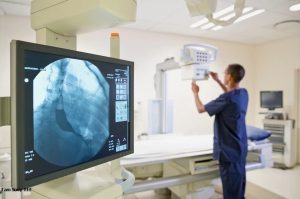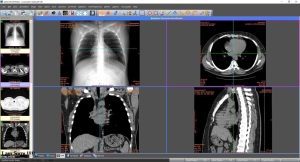Medical imaging uses a variety of techniques to gain a deep understanding of medical problems and reach an accurate diagnosis. To better understand the devices and systems used to manage and interpret images, let’s look at the two most important techniques in the region: PACS and DICOM (Digital Communications in Medicine and PICTURE Archiving and Communication System).
The purpose of this article is to clarify the difference between PACS and DICOM, their roles in medical imaging and their interpretation, while also detecting their applications beyond radiology.
What is DICOM?
Definition of DICOM
DICOM means digital imaging and communication in medicine. It is an international standard that is used to store, transfer, and handle medical imaging information and related data.
Crucially, DICOM is not a specific software or piece of hardware. Instead, there is a professional standard for managing the processing of digital images in the medical field.
Development of history and development
Standardizing the exchange of medical imaging data was intended to increase equipment and system interoperability.
Before PACS and DICOM, each piece of medical equipment required proprietary equipment or software to read and translate images manufactured in some useful format. DICOM made it easy to use equipment from various medical facilities manufacturers, such as hospitals, without the need for extra expenses.
Central features in DICOM
Medical imaging standardization: DICOM makes sure that pictures and associated information work with various equipment and manufacturers.

Radiology
Cardiology
Other medical fields, including dentistry, pathology, and dermatology, where imaging is necessary for diagnosis and treatment.
What are PACS?
Definition of pac.
PACS and DICOM do not refer to a file format or image standard, but the way these images are stored, accessed, and transferred between doctors and patients, internal experts and external advisors, and more.
History and development of pac
PACS was developed as a solution to the disabilities of traditional film-based imaging, providing easy access to digital storage and images. Today, PAC includes websites and cloud-based solutions, and can be optimized based on convenience.
Main features of PAC
Storage, recovery, control, and distribution: PACs handle the entire life cycle of medical images for collection.
Integration with hospital information system: PAC is often integrated with other systems, such as Electronic Health Records (EHR), for extensive patient care.
General use of PAC
While PACs are mainly used in radiology, their applications are expanded:
Radiology: X-rays, MRI, CT scan, and more to handle.
Other medical fields, such as oncology and orthopedics, are where imaging is important.
Separates Dicom vs. PACS?
Basic difference between DICOM and PACS
DICOM is a technical standard for an image as well as a file format for images. These images can be accessed using the PACS system.
DICOM: A standard for image format and communication.
PACS: A system for storing and managing images.
Or to put it another way, you can access a DICOM image through the hospital’s PACS system.
What are the differences between PAC and DICOM?
PACS and DICOM systems (Picture Archive and Communication System) are medical imaging techniques for storing, retrieving, and communicating medical images. It is a computer-based system that provides electronic access to images and reports from different methods such as CT, MRI, and ultrasound.
What are the four main components of PACs?
Modely: This is a medical image apparatus, such as a CT scanner or MRI machine, used to get images.
Medical images and data are stored and managed by the PACS and DICOM server, a data tab system. This includes a database for storing the software and hardware required to process images and data and images.
Workstation: There is a computer used by health professionals to see and manipulate medical images. It usually contains a PACS client, a software that lets users now photos stored on the PACS server.



The network is the infrastructure that links the workstation, PACS, and dicom server, and Tarike. It can be a single feature or a local network in a wide network (WAN) that combines several features in a large geographical area. The network allows different components of the PACS system to communicate and exchange data.
DICOM (Digital Imaging and Communications in Medicine) is a standard for the storage, broadcasting, and communication of medical images and related data.
How is DICOM used with PACs?
Dicom and Pacs Inter – Presented by Postdicom.
DICOM is used by PACs to store and exchange medical data and images. Medical images captured with a technology like a CT scanner are frequently stored in the DICOM format. After that, the DICOM image is sent to PACS and DICOM server, which is a central place to manage and store medical images.
When the DICOM image is stored on the PACS server, it can be provided by authorized healthcare professionals using the PACS client. This software application allows users to see, manipulate, and share images. PACS and DICOM work together seamlessly, as the PACS client communicates with the PACS server using the DICOM standard to recover and view the images.
In addition to storing and transferring images, DICOM includes images and related information, such as patient demographics, image collection parameters, and standardized data elements describing the clinical report.
Can Pac work without Dicom?
PACs can technically work without a DICOM, but the functionality will be quite limited. It is mainly designed to trust DICOM to manage medical imaging data.
Let’s see that without Dicom, Pac’s borders can be met.
Image format and standard: In the absence of DICOM, PACs might need non-standard formats, which could lead to incompatibilities.
Interoperability issues: DICOM makes it possible to integrate imaging equipment with systems like His or RIS. PACs will suffer from a disjointed workflow and a bad connection without it.
Data sharing: DICOM allows secure and even image sharing. PACs alone cannot complete it effectively.
Seller lock: Non-daily PACs can rely on proprietary protocols, which can cause dependence on specific suppliers and complicate data.
Role in the imaging workflow
DICOM and PAC are complementary in workflows for medical imaging.
DICOM’s role in the depiction of workflow.
DICOM ensures that imaging units produce data in a standardized format, which helps preserve the integrity of the image and the related metadata
PACS role in the imaging workflow
PACS radiology serves as a central location for workflows to store and preserve medical images. When the DICOM format and transfer of images are used, PACS systematically saves them.
PACs enable health professionals to easily restore, compare, and analyze images.
Data Handling and Management
DICOM focuses on coding and transmission of imaging data. This ensures that images also retain their original quality during transfer through different systems.
PACS and DICOM specialize in storing and administering image processing data, making it easier for health care professionals to use the study using a patient, D, imaging type, or study date. It also provides secure long-term storage for future references, either cloud-based or in-powered PAC.
Interoperability and integration.
DICOM and PACs help interpret in unique ways.
DICOM guarantees compatibility in imaging units and systems. It acts as a universal translator so that the equipment of different manufacturers can share data without compatibility problems.
PACS increases interoperability by integrating with other IT systems in the healthcare system. These systems include-
Rice (Radiology Information System)
His (hospital information system)
EHR (electronic health records)
Medicaid safely connects various medical systems to collect imaging data from PAC, RIS, and his to improve the patient’s care.
Dickom and PAC are only used in radiology?
DICOM and PACs are mainly used in radiology. However, his application extends to several medical specialties.
Cardiology: Dicom stores PACs, performs these examinations, and assists with echocardiograms and angiograms.
Oncology: PACS and DICOM help to track tumor progression through sequential imaging studies.
Pathology: DICOM standard Digital Pathology helps to handle the slide, while PACS provides storage and recovery solutions.
Types of PACS systems
Each type of PACS and DICOM system meets different operating requirements and budgets, but all depend on DICOM standards to function effectively.
Pac-er based on
IT of a hospital or clinic is locally installed in the infrastructure. Provides high control and adaptation, but requires significant maintenance and advanced costs.
Cloud-based pac
At any time on the cloud, at any time, provides external access to photos anywhere. Scalability, ideal for collaboration, and reduced it.
Hybrid
Connects to radius and cloud functions, provides flexibility in data storage, and ensures important data.
Seller-Plate Collection (VNA) Integrated PAC
Supports storage and access to medical images from many suppliers, promotes interoperability, and provides long-term data management.
How Dicom and PAC complement each other
DICOM: This ensures that images are properly formatted and transmitted between the equipment.
PACS: Offers stores and manages these images effectively.

How is DICOM used with PACs?
DICOM role in PAC
PACS and DICOM are important to ensure that images from different imaging units can be stored and accessed by PACs. DICOM standardizes the image formats, which enables spontaneous integration.
Examples of workflow: From image collection to storage and recovery
Image capture: Imaging equipment is used to obtain medical images.
DICOM formatting: DICOM standards were followed in the formatting of these photos.
PACS retrieval and storage: PACS includes formatted images that can be recovered when necessary.
Is Pac able to function without Dicom?
The landscape’s theoretical potential
A PACS and DICOM are not limited to the standard, but since DICOM is an accepted standard for medical imaging equipment, almost everyone will focus on the treatment and management of all PACS DICOM files.
Practical boundaries and challenges
Lack of interoperability: Without DICOM, different imaging units and systems cannot be compatible.
Integration problems: Non-standard data can cause significant challenges in integrating with other healthcare systems.
The benefits of using DICOM with PACS
Better interpretation: Different systems can work together.
Standard data exchange: The system for sharing and management of medical images on different platforms.
Manufacturers of medical equipment and those who supply PACS solutions are typically focused on DICOM, especially with a focus on data management and conservation, which becomes easier with an integrated DICOM PACS system.
DICOM and PAC are only used in radiology?
No, but both PACs and DICOM are associated with medical imaging. Outside of radiology, this means that PACs and DICOM can be found in other medical fields.
Application of PACs and DICOM in other medical fields
Cardiology: echocardiograms, MR-heart, and other heartbeat depictions.
Oncology: to track tumor progression and reactions.
Pathology: For slides and analysis of digital pathology.
The benefits of DICOM and PACS in these areas
Promotion Image Management: The process of sharing, restoring, and restoring is strengthened by the medical photos.
Better patient care: Timely and accurate diagnosis and treatment plans facilitate.
Even beyond radiology, DICOM and PAC work together to improve the ease of handling medical images and distribute health results quickly.
Conclusion.
It is important to understand the difference between PACs and DICOM for health professionals involved in medical imaging. While DICOM standardizes the format and transfer of therapy images, PACS provides a comprehensive system for these images stored and control.
Together, they increase the efficiency and effectiveness of medical imaging and eventually improve the patient’s care. As technology goes on, the integration and application of PACS and DICOM are likely to be expanded, which will cause further revolution in medical imaging.

It is necessary to understand the difference between DICOM and PAC for health professionals working with medical images and data. Healthcare doctors can increase the accuracy, efficiency, and access to patient care through the successful use of these strategies together with medical imaging.

